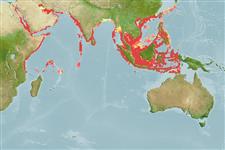Classification / Names
Common names from other countries
Main reference
Size / Weight / Age
Max length : 32.0 cm TL male/unsexed; (Ref. 3836); common length : 25.0 cm TL male/unsexed; (Ref. 5450); max. published weight: 596.00 g (Ref. 1448); max. reported age: 8 years (Ref. 1448)
Length at first maturity
Lm 14.0 range ? - ? cm
Environment
Marine; demersal; non-migratory; depth range 5 - 80 m (Ref. 9785)
Climate / Range
Tropical, preferred 28°C (Ref. 107945); 34°N - 11°S, 31°E - 133°E (Ref. 3810)
Distribution
Short description
Dorsal
spines
(total): 10;
Dorsal
soft rays
(total): 9;
Anal
spines: 3;
Anal
soft rays: 7. Eleven to twelve pale golden-yellow stripes along body from behind head to base of caudal fin. A prominent red-suffused yellow blotch below origin of lateral line. Pectoral fins very long, reaching to or just beyond level of origin of anal fin. Caudal fin moderately forked, upper lobe slightly longer than lower and produced into a short or moderately long filament. Three transverse scale rows on preopercle. Axillary scale present. Color: Upper body pinkish, silvery below.
IUCN Red List Status (Ref. 115185)
Threat to humans
Harmless
Human uses
Fisheries: commercial
Tools
Special reports
Download XML
Internet sources
Estimates of some properties based on models
Phylogenetic diversity index
PD50 = 0.5000 many relatives (e.g. carps) 0.5 - 2.0 few relatives (e.g. lungfishes)
Trophic Level
3.8 ±0.51 se; Based on food items.
Resilience
Medium, minimum population doubling time 1.4 - 4.4 years (K=0.29-1.06; tm= 0.5-1.4; tmax=8; Fec = 13,900)
Vulnerability
Low to moderate vulnerability (26 of 100)
Price category
